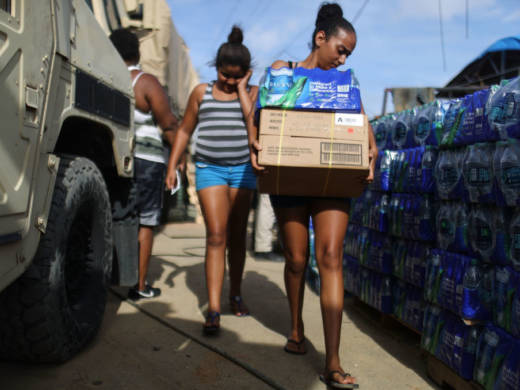A typical meal plan using the foods found in the FEMA warehouse could include a ready-to-eat cereal and milk for breakfast, a morning and afternoon snack like dried peanuts or a cereal bar, tuna salad and crackers for lunch and a pre-packaged pasta dinner, Colón-Ramos says.
Following the meal plan with these foods would meet the DGA food group recommendations but exceed the dietary limits for salt, saturated fat, or added sugars.
In a situation where disaster has wiped out food options, people are happy for help. And who would deny a child who has been through a hurricane a piece of candy? But it doesn't make for a healthy eating plan in the long-term, which is what some food assistance operations in disaster zones sometimes become. As NPR has reported, the island is still struggling to access power and rebuild.
"In the past and traditionally, not just in the U.S. but globally, food aid has been focused on providing enough calories and enough water," Colón-Ramos says. "It makes perfect sense: You don't want people to be hungry, and you don't want people to die out of dehydration."
But now, this type of aid may be outdated and unhealthy. Thirty to 35 percent of Puerto Rican adults already are obese.
Ursula Marcos Tovar, a Manati, Puerto Rico, resident, received a FEMA box in October. She says the contents of the box were applesauce cups, animal-shaped cookies, beef jerky, canned pasta, bottled water and plastic cutlery. At that time, she and her family did not have power or water.
The box, which were handed out to each of the homes in her community, was too small to sustain her family of four for long, but luckily food stores in the area were starting to open. Marcos Tovar says at the time, there was only dry food available and the ATMs weren't working due to power outages.
For the first two to three months after Maria, this was all the food her family could access. She only received one box of FEMA food aid during this time.
"I'm thankful for [the food], it was a terrible time after Maria," she says. "It was a little, but it was something."
In the municipality where Colón-Ramos did her analysis, she found that there was extremely low access to healthy food even before the hurricane. There was only one major grocery store in the entire municipality, with the rest being small corner shops.
Colón-Ramos says food aid should increase accessibility to nutritious food for survivors. People in the area already had access to candy and chips through local stores, but none of them had options like nonfat milk. Fruits and vegetables were limited, as well as low-sodium protein options. Those are the kinds of things that FEMA should have been providing, she says.
"Any foods that are distributed by the federal programs need to abide by the U.S. dietary guidelines," she says, including limits on salt, sugar and fat.
Colón-Ramos says the federal government also offers emergency SNAP programs that allow survivors to purchase their own food. But in a situation like this, where grocery stores are limited, people could only get more of the same high-sodium and sugar snacks.
FEMA said in an email to NPR that food aid meals meet guidelines developed in consultation with various groups, including the U.S. Department of Agriculture. In a short shelf-life meal, there would be a fat content of 47 grams or less and a sodium limit of 800 milligrams, FEMA says. FEMA did not mention any requirements on sugar content.
While individual meals or snacks may fall under the fat or sodium content, Colón-Ramos found that many could not simultaneously fit the food groups in the Dietary Guidelines' daily recommendations.
For example, one serving of canned Chef Boyardee ravioli that could be found in these boxes has a full meal's worth of sodium and seven grams of fat.
FEMA manages multiple contractors, and according to The Washington Post, is moving away from MREs and snacks and towards grocery boxes and hot meals.
The food aid nutrition challenge isn't new. Greg Gottlieb, a professor in nutrition and human security at Tufts who was not involved in the research, says that in the late 1990s, he ran into a problem like this one when delivering aid to the Soviet Union.
"When we opened up some of those packages, they were candy," he says. "There were Twizzlers."
Dried fruits like raisins and apricots could be a healthier option, but it's also important to analyze what people actually eat where the aid is being delivered, he says. On top of that, it's hard to escape sodium in things like canned tuna and vegetables.
Colón-Ramos says there is a need for better monitoring of food aid and its health value, as well as more specific guidelines for those providing help.
"We're seeing a larger prevalence of chronic diseases that are diet-related, and we're taking that in to consideration in food aid," she says. "And we should, because those are now the most vulnerable populations to these kinds of disasters. The repercussions of what we may provide ... it could have repercussions on people's health."
